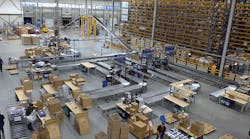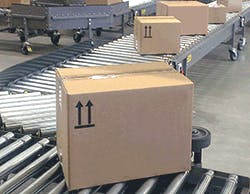We often think of unloading and loading operations as consisting of multiple conveying solutions that help get product into or out of a facility. These types of conveyor solutions generally include permanently installed configurations deep within the facility, with potentially the only flexibility being a powered or gravity conveyor at the end of a complex system that stretches from the dock into the bed of the trailer. These types of conveyor systems generally restrict movement of personnel and industrial trucks used in the dock area. A fixed configuration conveyor system is efficient for certain types of products and loading/unloading operations, but becomes restrictive when changes are necessary for different types of product flow often found in modern distribution centers.
Many DCs are now engaged in both e-commerce fulfillment directly to customers as well as store replenishment on a daily basis. Products loaded/unloaded range from small package shipments to pallet-sized store replenishment. During certain periods in the warehouse, small packages may be the preponderance of items moved and then during other periods, forklift operations of pallet-sized loads may commence. Adding seasonal item shipments to the mix creates the need for even more flexibility in the DC's total dock operations.
Driven by market demand, e-retailers will be continually expanding their product line offerings, spawning the need for more innovative and flexible loading/unloading operations. Medium-sized e-commerce companies may want to avoid large capital equipment investments yet require rapid movement of product in the dock area with item tracking and sorting capability. With the growing need for speed and efficiency, how does a distribution center optimize multiple operations while minimizing setup times and space requirements of conveying equipment?
A concept recently introduced to the material handling equipment market offers a modular approach where various conveyor components required for a particular operation are linked together to create the optimal system in a very short period of time and without professional engineering requirements. A primary assumption in equipment and system design is the flexibility to meet changing product flow conditions on a daily basis.
One company now offering a flexible, building block approach to dock operations is FMH Conveyors (www.flexmh.com) with their new BestConnect reconfigurable conveyor systems. Kurt Huelsman, senior vice president and general manager at FMH Conveyors, identifies several advantages to the modular approach. Huelsman states, "This concept serves distributors who want simpler systems without large hardware investments. [The idea is] to provide automation at a lower cost entry point and give the distributor the flexibility to reconfigure the loading area for changing product dimensions and volumes."
The modular components include flexible powered roller conveyor, ball transfer, merge, curves, accumulation sections and gravity. Scanners can be added to various components as required for tracking input into a user's warehouse control system/warehouse management system (WCS/WMS). All components operate on 110-volt electrical current, thereby minimizing infrastructure requirements. The components are married together with easy-to-connect latching devices. The engineering requirements necessary to build a system in a dock area are minimal. When operational requirements change and the loading area must be cleared, the modular components can be quickly disassembled and stored. The initial investment and follow-on costs of this type of system is less than a fixed conveyor system.
Huelsman notes some of their e-commerce customers began seeking more flexible solutions necessary to meet multi-faceted distribution operations. In order to meet this requirement, their engineers took the best of various conveyor components and created a synergy through a modular approach. As a result, users have the opportunity for multiple modes of processing. It can be connected to current loading and/or unloading processes, or it can serve as a standalone processing, shipping, or packaging system.
What benefits will distribution center operators realize by utilizing this concept? They will have the advantages of powered conveyor systems without the higher initial engineering and capital layout costs. Professional installers and electricians are not required to change configurations. Accessories can be added or subtracted as required and none are permanently fixed to floors. When loading areas are required for pallet or large container staging, the conveyor system can be quickly disassembled and stored out of the way.
In conclusion, as e-commerce firms seek to meet a myriad of customer demands for products, they will require more flexibility in their distribution center loading/unloading operations. Their investments in material handling equipment will need to provide opportunities to change modes with changing customer preferences, transportation services and seasonal requirements. Solutions should be implemented quickly without major hardware replacement.
Modular flexible loading/unloading systems can keep distributors on the cutting edge of distribution process in a rapidly changing market environment. One of the tenets of adaptive distribution planning should be, "Don't buy new dock conveying equipment. Reconfigure and optimize what you already own."
Alan Will is president of PWG Distribution Solutions LLC (www.pwgds.com), specializing in analysis of logistics requirements for small and medium-sized firms. A retired Marine Colonel, logistics specialist, he is also a member of MH&L's Editorial Advisory Board.




